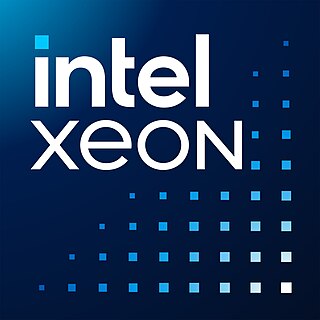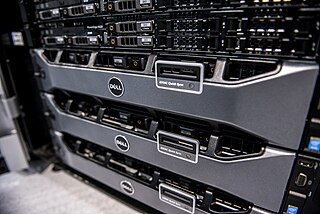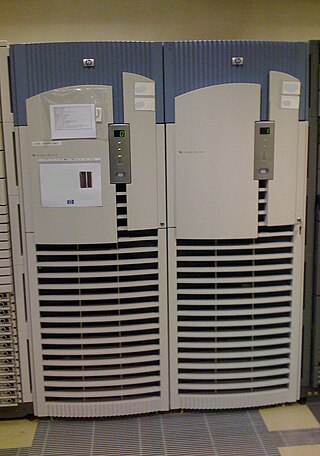
Itanium is a discontinued family of 64-bit Intel microprocessors that implement the Intel Itanium architecture. The Itanium architecture originated at Hewlett-Packard (HP), and was later jointly developed by HP and Intel. Launched in June 2001, Intel initially marketed the processors for enterprise servers and high-performance computing systems. In the concept phase, engineers said "we could run circles around PowerPC...we could kill the x86." Early predictions were that IA-64 would expand to the lower-end servers, supplanting Xeon, and eventually penetrate into the personal computers, eventually to supplant reduced instruction set computing (RISC) and complex instruction set computing (CISC) architectures for all general-purpose applications.

System x is a line of x86 servers produced by IBM, and later by Lenovo, as a sub-brand of IBM's System brand, alongside IBM Power Systems, IBM System z and IBM System Storage. In addition, IBM System x was the main component of the IBM System Cluster 1350 solution.

Xeon is a brand of x86 microprocessors designed, manufactured, and marketed by Intel, targeted at the non-consumer workstation, server, and embedded markets. It was introduced in June 1998. Xeon processors are based on the same architecture as regular desktop-grade CPUs, but have advanced features such as support for error correction code (ECC) memory, higher core counts, more PCI Express lanes, support for larger amounts of RAM, larger cache memory and extra provision for enterprise-grade reliability, availability and serviceability (RAS) features responsible for handling hardware exceptions through the Machine Check Architecture (MCA). They are often capable of safely continuing execution where a normal processor cannot due to these extra RAS features, depending on the type and severity of the machine-check exception (MCE). Some also support multi-socket systems with two, four, or eight sockets through use of the Ultra Path Interconnect (UPI) bus, which replaced the older QuickPath Interconnect (QPI) bus.

Altix is a line of server computers and supercomputers produced by Silicon Graphics, based on Intel processors. It succeeded the MIPS/IRIX-based Origin 3000 servers.

Sun Fire is a series of server computers introduced in 2001 by Sun Microsystems. The Sun Fire branding coincided with the introduction of the UltraSPARC III processor, superseding the UltraSPARC II-based Sun Enterprise series. In 2003, Sun broadened the Sun Fire brand, introducing Sun Fire servers using the Intel Xeon processor. In 2004, these early Intel Xeon models were superseded by models powered by AMD Opteron processors. Also in 2004, Sun introduced Sun Fire servers powered by the UltraSPARC IV dual-core processor. In 2007, Sun again introduced Intel Xeon Sun Fire servers, while continuing to offer the AMD Opteron versions as well.
A logical partition (LPAR) is a subset of a computer's hardware resources, virtualized as a separate computer. In effect, a physical machine can be partitioned into multiple logical partitions, each hosting a separate instance of an operating system.
The Intel Core microarchitecture is a multi-core processor microarchitecture launched by Intel in mid-2006. It is a major evolution over the Yonah, the previous iteration of the P6 microarchitecture series which started in 1995 with Pentium Pro. It also replaced the NetBurst microarchitecture, which suffered from high power consumption and heat intensity due to an inefficient pipeline designed for high clock rate. In early 2004 the new version of NetBurst (Prescott) needed very high power to reach the clocks it needed for competitive performance, making it unsuitable for the shift to dual/multi-core CPUs. On May 7, 2004 Intel confirmed the cancellation of the next NetBurst, Tejas and Jayhawk. Intel had been developing Merom, the 64-bit evolution of the Pentium M, since 2001, and decided to expand it to all market segments, replacing NetBurst in desktop computers and servers. It inherited from Pentium M the choice of a short and efficient pipeline, delivering superior performance despite not reaching the high clocks of NetBurst.

The PowerEdge (PE) line is Dell's server computer product line. PowerEdge machines come configured as tower, rack-mounted, or blade servers. Dell uses a consistent chip-set across servers in the same generation regardless of packaging, allowing for a common set of drivers and system-images.

Pentium is a discontinued series of x86 architecture-compatible microprocessors produced by Intel. The original Pentium was first released on March 22, 1993. The name "Pentium" is originally derived from the Greek word pente (πεντε), meaning "five", a reference to the prior numeric naming convention of Intel's 80x86 processors (8086–80486), with the Latin ending -ium since the processor would otherwise have been named 80586 using that convention.

Windows IoT, short for Windows Internet of Things and formerly known as Windows Embedded, is a family of operating systems from Microsoft designed for use in embedded systems. Microsoft has three different subfamilies of operating systems for embedded devices targeting a wide market, ranging from small-footprint, real-time devices to point of sale (POS) devices like kiosks. Windows Embedded operating systems are available to original equipment manufacturers (OEMs), who make it available to end users preloaded with their hardware, in addition to volume license customers in some cases.

ProLiant is a brand of server computers that was originally developed and marketed by Compaq, Hewlett-Packard (HP), and currently marketed by Hewlett Packard Enterprise (HPE). ProLiant servers were first introduced by Compaq in 1993, succeeding their SystemPro line of servers in the high-end space.
Logical Domains is the server virtualization and partitioning technology for SPARC V9 processors. It was first released by Sun Microsystems in April 2007. After the Oracle acquisition of Sun in January 2010, the product has been re-branded as Oracle VM Server for SPARC from version 2.0 onwards.
The ES7000 is Unisys's x86/Windows, Linux and Solaris-based server product line. The "ES7000" brand has been used since 1999, although variants and models within the family support various processor and bus architectures. The server is marketed and positioned as a scale-up platform where scale-out becomes inefficient. Typically the ES7000 is utilized as a platform for homogeneous consolidation, large databases, Business Intelligence, Decision Support Systems, ERP, virtualization, as well as large Linux application hosting.

The HP Superdome is a high-end server computer designed and manufactured by Hewlett Packard Enterprise. The product's most recent version, "Superdome 2," was released in 2010 supporting 2 to 32 sockets and 4 TB of memory. The Superdome used PA-RISC processors when it debuted in 2000. Since 2002, a second version of the machine based on Itanium 2 processors has been marketed as the HP Integrity Superdome.
LGA 1567 or Socket LS, is a CPU socket used for the high-end server segment. It has 1567 protruding pins to make contact with the pads on the processor. It supports Intel Nehalem, codenamed Beckton, Xeon 7500 and Xeon 6500 series processors first released in March 2010. The 6500 series is scalable up to 2 sockets, while the 7500 series is scalable up to 4/8 sockets on a supporting motherboard. In this server segment, it is a successor of Socket 604, which was first launched in 2002. A modification of LGA 2011, the LGA 2011-1 or Socket R2, is a successor of LGA 1567.
The Fujitsu Celsius is a line of laptop and workstation computers manufactured by Fujitsu. The brand name has also been used for graphic accelerators.

PureSystems is an IBM product line of factory pre-configured components and servers also being referred to as an "Expert Integrated System". The centrepiece of PureSystems is the IBM Flex System Manager in tandem with the so-called "Patterns of Expertise" for the automated configuration and management of PureSystems.
Intel Ivy Bridge–based Xeon microprocessors is the follow-up to Sandy Bridge-E, using the same CPU core as the Ivy Bridge processor, but in LGA 2011, LGA 1356 and LGA 2011-1 packages for workstations and servers.















